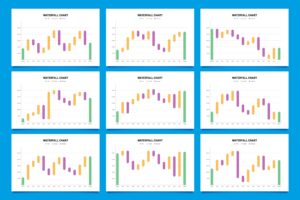In trading, perfecting your timing helps, but it’s not everything. Beginners frequently lose funds chasing fast returns. They enter without guidance, take unnecessary risks, and end up blowing their accounts. Unfortunately, this happens more frequently than most realize. Thankfully, using a proper method can help avoid this situation entirely.
Trading wisely can transform your financial future. However, it demands respect. Handle it as seriously as running a business. Achieving results takes strong discipline and a clear method. This post shares bold, simple steps to grow consistency and safeguard your trades. Let’s dive in and explore what separates blown accounts from balanced portfolios.
Table of Contents
Why Traders Blow Their Accounts in Trading
Wiping out your account means major capital loss. More traders experience this than most would initially believe. But why does it happen?
One major reason is over-leveraging. Traders often use borrowed money to increase profits. However, this also increases risk. Minor price shifts can erase your full balance.
Lack of proper education is another big cause. Many jump into trading after watching videos or hearing success stories. They assume it’s easy money. Without training, this assumption becomes a trap.
Also, revenge trading can be deadly. When traders lose, they often try to win it back quickly. This triggers impulsive moves and deeper financial setbacks. Instead, they should pause, evaluate, and return with a clear head.
Overconfidence, lack of discipline, and greed are also major triggers. You must identify and eliminate these behaviors to grow as a trader.
Fearless Ways to Stop Losing Money
Thankfully, there are fearless ways to protect your account. These aren’t shortcuts — they’re tested habits and solid plans. Let’s explore them.
Stick to a Solid Plan
A good trading plan acts like navigation in unfamiliar market conditions. It directs your actions and clarifies each trading decision. A good plan covers entries, exits, risk rules, and strategy.
Don’t change your plan mid-trade. Traders often tweak plans due to emotions. However, doing so leads to confusion and losses. Always trust your tested plan.
Keep your plan simple, measurable, and consistent. If you can’t explain your strategy to a 10-year-old, it might be too complex.
Also Read: Nifty Expiry
Use Proper Risk Management in Trading
Only risk a small portion, around 1–2%, per trade. This rule protects you from large losses. Even a losing streak won’t destroy your trading account if you follow this.
Use stop-loss orders wisely. They limit your downside and help maintain discipline. Experienced traders depend on strict risk control practices.
Also, consider using position sizing calculators. They help manage capital wisely while keeping emotions under control.
Learn from Every Loss
Every trade, win or lose, teaches something. Note every trade along with how you felt while placing it. Over time, this helps you spot patterns and improve.
Don’t ignore your mistakes. Reflect on them and learn. Strong mindset is essential for succeeding over time in it.
Treat every loss as tuition. Focus on skill growth, not just quick earnings.
Also Read: ETFs
Avoiding Psychological Traps
Overconfidence Can Kill Your Trading Account
After a few wins, traders feel unstoppable. They increase lot sizes or ignore rules. Unfortunately, the market humbles everyone. Stay grounded.
Even pros experience losses. Accept them as part of the game. Handling losses well matters more than celebrating wins.
The best traders remain humble and focused, no matter how much they make.
Impatience Leads to Poor Choices
Many new traders want fast results. This leads to overtrading. However, quality trades beat quantity. Waiting for the right setup is a skill.
Develop patience through practice. Set alerts, walk away from the screen, or trade higher timeframes. Let the market come to you.
Impatience creates chaos. Patience creates profits.
Also Read: Candlestick Trading
Useful Tools for Building Consistency
Use Trading Simulators Before Going Live
Simulators let you practice it without risking money. They are great for testing strategies. Once confident, move to a small live account.
Many brokers offer demo accounts. Use them to learn the platform. Mistakes in a demo don’t cost money, but they teach lessons.
Start small. Build confidence. Then scale.
Also Read: Fundamental Analysis
Use Alerts and Automation
Also Read: Sector Rotation
Key Takeaways for Safe and Fearless Trading
Let’s recap the most important points:
- No strategy in trading means you’re drifting aimlessly
- Risk management is your best defense
- Emotional control is critical for account survival
- Use tools and practice before going live
- Always keep learning
You don’t need to fear the market. Tackle trading using calm, planning, and self-control. Your account will thank you for it.
Also Read: Gift Nifty
Frequently Asked Questions About Trading
What is trading, exactly?
It involves swapping financial instruments to gain profit from market changes. This includes stocks, forex, crypto, and more.
How much capital do you need to begin efficiently?
You can begin with $100, but $500+ is more reliable for consistency. It depends on your broker, market, and strategy.
Can I trade without experience?
It’s possible, but not recommended. Learn how trading works by using a no-risk demo account first. Rushing in leads to blown accounts.
Is trading suitable for everyone?
No. It requires discipline, risk tolerance, and emotional control. It’s not a get-rich-quick scheme.
How can I stop blowing my trading account?
Follow a plan, manage risk, stay calm, and keep learning. Avoid over-leverage and revenge trading.
Also Read: Double Top
Conclusion
Wiping out your account isn’t impressive — it’s a costly learning experience. The best part? You can avoid that mistake entirely. By following fearless, structured habits and staying emotionally grounded, you can trade smartly and consistently. The path to successful trading isn’t paved with shortcuts; it’s built on discipline, patience, and a willingness to learn from every mistake. Stick with your strategy, manage risk carefully, and gains will eventually follow.
Also Read: Color Trading Mastery







